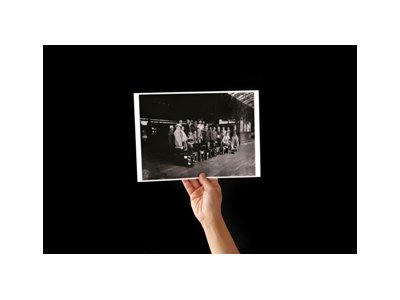
Langue : français / Sous-titré en néerlandais
Lire l’interview de Olga de Soto dans Agenda Magazine
FR Sur un plateau nu, secondée par un écran où défilent vidéos et images d’archives, Olga de Soto nous parle de La Table Verte, célèbre ballet du chorégraphe allemand Kurt Jooss. Suite à la présentation de Débords, Une Introduction est un moment d’ouverture et de proximité destiné à accorder autant d’importance au partage du processus de création qu’à l’aboutissement de l’œuvre. La chorégraphe interroge sous la forme d’une performance documentaire l’histoire du ballet de Kurt Jooss et y présente l’avant et l’après spectacle, son processus et son empreinte, exposant sur scène ce qui habituellement reste en marge. Elle retrace un processus de travail complexe, truffé de questionnements, de pistes esquissées et suivies lors d’un travail de documentation de longue haleine qui tient de la vraie enquête. Par ce travail de détective aux trouvailles parfois inespérées, elle réaffirme l’importance de la mémoire collective et rend hommage aux nombreuses personnes qui ont pris part aux représentations de La Table Verte.
NL Uitgangspunt van deze documentary-performance is het legendarische ballet De Groene Tafel van choreograaf Kurt Jooss. Jooss creëerde dit ballet in 1932, enkele maanden voor Hitler aan de macht kwam in Duitsland, in een periode van opkomend fascisme. Op basis van beeld-, tekst- en geluidsmateriaal en interviews met o.a. dansers en publiek, onderzoekt de Soto de vragen die rezen rond De Groene Tafel en de sporen die de voorstelling heeft nagelaten doorheen de jaren. Hoe herinneren toenmalige dansers en publiek zich de voorstelling ? Wat is hun perceptie ? Hun interpretatie ? Hoe evolueert een kunstwerk binnen zijn eigen geschiedenis, en binnen de geschiedenis in het algemeen ? Une introduction is een documentary-performance over een iconisch stuk uit de dansgeschiedenis, gemaakt op een scharnierpunt tussen twee oorlogen.
EN An Introduction is the first part of Olga de Soto’s project that focuses on Kurt Jooss’s legendary work The Green Table, premièred in 1932, a few months before Hitler rose to power in Germany. This piece is considered as a fundamental work in Dance History owing to the themes it deals with : the raise of fascism and war. Olga de Soto shares the research and creation process, in a moment of openness and intimacy, unveiling the backstage of a real detective work. Wholeheartedly, the choreographer presents the numerous enigmas that arose around Jooss’s masterpiece throughout the years and in the very particular contexts of different pivotal points in History. She questions the traces that it has left on people, on dance history. Through archive images, texts and moving interviews of dancers and spectators, Olga de Soto interrogates the impact of Kurt Jooss’s work. After considerable years of research, long journeys, emotional adventures, the choreographer offers the voyage on how a work of art evolves in its own history and through time and context.
CONCEPT, DOCUMENTATION, TEXT, PRESENTATION, CAMERA AND SOUND Olga de Soto
WITNESS STATEMENTS BY (in order of appearance) Micheline Hesse, Brigitte Evellin, Suzanne Batbedat, Françoise Olivaux, Frederic Stern, Françoise Dupuy and Michelle Nadal
VIDEO DIRECTOR Olga de Soto
VIDEO EDITING Julien Contreau & Olga de Soto
EXTRACTS FROM “The Green Table”, BBC 1967, BBC Motion Gallery.
VOICE OFF Kurt Jooss (extract from the interview Berghson-Jooss, California, 1974, courtesy of Tanzarchiv Köln)
SOFTWARE FOR CREDITS MOVIE Pierre Gufflet
TECHNICAL DIRECTOR Christophe Gualde
LIGHT TECHNICIAN Geni Diez
VIDEO AND SOUND TECHNICIAN Bram Moriau or Julien Lamaze
RESEARCH ASSISTANT AT TANZARCHIV KÖLN Katja Herlemann
PICTURES TAKEN BY Kurt Hegel, Marian Reisman, Fritz Henle, & unknown photographs. Three pictures from the “The Green Table” by Albert Renger-Patzsch/Albert Renger-Patzsch Archiv – Ann und Juergen Wilde / VG Bild-Kunst, Bonn / SABAM, Belgium 2010.
PROGRAM NOTES WERE COURTESY OF THE ARCHIVES OF Ballet Arizona, Ballet du Rhin, Bayerisches Staatballett, Birmingham Royal Ballet, former Cleveland Ballet now San José, Cullberg Ballett, Deutschen Tanzarchiv Köln (for Folkwang Tanztheater, Ballets Jooss, Folkwang Ballet & Tanzforum Köln), Finnish National Ballet, Les Grands Ballets Canadiens, Het National Ballet, Israel Dance Library – Tel-Aviv (for Batsheva Dance Company), Joffrey Ballet, José Limón Dance Foundation, Malmo Stadsteater, Oakland Ballet, Richmond Ballet, Tanzarchiv Leipzig (for Deutsche Oper, Berlin), Winnipeg Royal Ballet & Zürich Ballet.
PRODUCTION Niels (Brussels), in collaboration with Caravan Production (Brussels)
COPRODUCTION Centre Chorégraphique National de Franche-Comté in Belfort (F), Les Halles (Brussels), Tanz im August (Berlin). SUPPORTED BY Ministère de la Fédération Wallonie-Bruxelles – Secteur danse, Jooss Archives (Köln/Amsterdam) of the Deutsches, Tanzarchiv Köln (German Dance Archives).
RESEARCH GRANTS Ministère de la Culture et de la Communication / Programme Aide à la Recherche et au Patrimoine en danse (France), Ministère de la Communauté française de Belgique – Secteur danse.
RESEARCH RESIDENCIES Centre Chorégraphique de la Fédération Wallonie-Bruxelles – Charleroi/Danses (2006-2009), Centre national de la Danse – Pantin (2006).
An Introduction is an analytical work that takes Kurt Jooss’ piece The Green Table as its starting-point.
- Le 13 juin 2014 à 15:51
- Le 13 juin 2014 à 20:30
